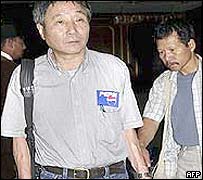Bigfoot Encounters
"Yeti's 'non-existence' hard to bear"
BBC UK--Friday, 26
September, 2003 --A row has erupted in Nepal after a Japanese
expert on Himalayan languages insisted the yeti was nothing more than
a case of linguistic mistaken identity.
Dr Matako Nabuka is a researcher and mountaineer who spent 12 years in Nepal, Tibet and Bhutan conducting, he says, research into the elusive abominable snowman.
Hackles began to rise in Kathmandu earlier this month when Dr Nabuka told a press conference in Tokyo yetis were not mysterious apes or hairy hominids living in the High Himalaya.
They were, quite simply, Himalayan brown bear, known in a regional Tibetan dialect as "meti", he said.
"This has spread too far," said Dr Nabuka, referring to belief in the yeti.
Many claim to have seen it, he said, but no one has proof.
The tribes of the Himalayas worship the brown bear as a deity, Dr Nabuka pointed out, and have endowed it with supernatural powers.
He said he had pictures of bear paws and other artefacts from the animal being venerated by mountain tribes people.
Linguistic dispute
But no sooner had the story hit the Nepali press than local opinion chimed in.
A letter to the editor of the Kathmandu Post headlined "Yetiquette" took Dr Nabuka to task for linguistic carelessness.
A "yeti" from contested footage shot in California in 1967
Signed by Bha Dawa, the letter says the Japanese researcher may have spent too long in the wrong mountains and had himself mixed up his words.
Both "yeti" and "meti" mean a near-mythical beast, said Mr Dawa.
Dr Nabuka has other opponents.
Dr Raj Kumar Pandey, who like the Japanese scientist researches both yetis and mountain languages, says it is not enough to blame tales of the mysterious beast of the Himalayas on words that rhyme but mean different things.
"Look at all the foreign expeditions that have seen [the yeti]," says Dr Pandey, naming British mountaineering legend, Eric Shipton, Italian super-mountaineer Reinhold Messner and the British Everest expedition leader from 1953, John Hunt.
"We have much more research to do on language and in zoology before we believe statements like this [from Dr Nabuka]."
Japanese rivalry
A very informal straw poll of mountaineers in Kathmandu carried out for BBC News Online at the city's legendary Rum Doodle Bar, a favourite hangout of climbers, found at least three people who claimed to have seen the yeti.
 Yoshiteru
Takahashi arrives in Kathmandu
Yoshiteru
Takahashi arrives in Kathmandu
"We'll get a picture this time and then all disbelievers will learn
their lessons," Yoshiteru Takahashi, rival to Dr Nabuka -->
None wanted their names used but all denied vehemently that their claims had anything to do with the amount of locally brewed Everest beer they were drinking.
In the end, it all probably comes down to rivalry between Japanese mountain-climbers.
Dr Nabuka's press conference came just weeks after Japan's most celebrated yeti-hunter, Yoshiteru Takahashi, left his country to make "the definitive attempt" to photograph the beast.
Mr Takahashi claims to have found a yeti cave on the slopes of Dhaulagiri, the world's fifth highest mountain, in western Nepal.
His camera froze in 1994 when he tried to photograph the denizens of the cave, he said in Tokyo before leaving.
This year, he is using nine infrared cameras with motion sensitive shutters, and wrapping them up well against the Himalayan chill.
"We'll get a
picture this time," he said, "and then all disbelievers will
learn their lessons."
- ---
Copyright: BBC news...
Article courtesy Mark Malone
Back
to "What's New"
Back
to Newspaper & Magazine Articles
Main
Portions of
this website are reprinted and sometimes edited to fit the standards of
this website under the Fair Use Doctrine of International Copyright Law
as educational material without benefit of financial gain.
http://www4.law.cornell.edu/uscode/17/107.html
This proviso is applicable throughout the entire website.